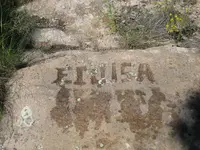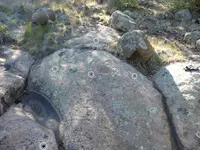You are using an out of date browser. It may not display this or other websites correctly.
You should upgrade or use an alternative browser.
You should upgrade or use an alternative browser.
Odd word, does anyone recognize it?
- Thread starter sdcfia
- Start date
dog the treasure hunter
Gold Member
- Joined
- Jan 16, 2011
- Messages
- 5,010
- Reaction score
- 5,039
- Golden Thread
- 0
- Location
- By, By Have fun.
- Detector(s) used
- Time to move on. Good luck everyone .
- Primary Interest:
- All Treasure Hunting
I dont know what it means. But it tells me you look for Treasures.
E TU ISA?
And you too study abroad?
Or...
And you too study abroad?
Or...
cyzak
Silver Member
- Joined
- Jul 14, 2018
- Messages
- 2,530
- Reaction score
- 4,211
- Golden Thread
- 0
- Location
- Mountains of Western Colorado
- Detector(s) used
- My intuition and conscious reasoning, a good tape measure and compass do the math its out there.
- Primary Interest:
- All Treasure Hunting
LOL you know it does not spell that not even close,remember I read your book.
Last edited:
Maverick1
Bronze Member
It's ALL Natural. Yep, the wind did it.
Those are Wind marks witnessed by Demis Roussos. Listen to the man Himself
...and while in Greece or Cyprus listen to such
Those are Wind marks witnessed by Demis Roussos. Listen to the man Himself
...and while in Greece or Cyprus listen to such
'etui
case cas, affaire, boîtier, cause, étui, caisse
cover
couverture, cache, abri, étui, fourreau, voile
sa
its ses, son, sa
his ses, son, sa
her ses, son, sa
Hi Sdc. Could be two French words, SA and 'ETUI. Might mean his or her cache. Don't know, but maybe you can make something out of it.
'Etui is also defined as holster, a pouch for carrying a sidearm, but the origin of holster could also indicate a hiding place.
[h=1]holster (n.)[/h]"leather case for a pistol," 1660s, probably from Old English heolster, earlier helustr "concealment, hiding place," from Proto-Germanic *hulfti- (source also of Old High German hulft "cover, case, sheath," Old Norse hulstr "case, sheath," Middle Dutch holster, German Halfter "holster"), from PIE root *kel- (1) "to cover, conceal, save." Intermediate forms are wanting, and the modern word could as well be from the Norse or Dutch cognates.
[h=1]holster (n.)[/h]"leather case for a pistol," 1660s, probably from Old English heolster, earlier helustr "concealment, hiding place," from Proto-Germanic *hulfti- (source also of Old High German hulft "cover, case, sheath," Old Norse hulstr "case, sheath," Middle Dutch holster, German Halfter "holster"), from PIE root *kel- (1) "to cover, conceal, save." Intermediate forms are wanting, and the modern word could as well be from the Norse or Dutch cognates.
Hush Mdog, you're giving away the shop. Lol
(right you are. Try Latin too)
Thanks for the hint, Maverick. I tried E TUISA in Latin and I came up with, OUT OF YOUR. Then I tried ET UISA and got, AND SNEER. What are you thinking on a Latin translation?
Maverick1
Bronze Member
That message is a mock. And is stated as such. The real message is on the triangle rock next to it. A triangle with a left bar on top (showing direction) and a shadow sign
within (dark) showing a cave or tunnel. A dark place.
About 80-90% of the solve is not shown in those pictures. The dots' pattern and the mini triangle rock shadow are hints to a larger area of research.More detailed pictures are needed.
But who's going to believe that......? Tricks of the right side of the brain.
P.S. ....a miniature black heart (as small as a dot) is smack on top & middle of the triangle rock. Go figure...
within (dark) showing a cave or tunnel. A dark place.
About 80-90% of the solve is not shown in those pictures. The dots' pattern and the mini triangle rock shadow are hints to a larger area of research.More detailed pictures are needed.
But who's going to believe that......? Tricks of the right side of the brain.
P.S. ....a miniature black heart (as small as a dot) is smack on top & middle of the triangle rock. Go figure...
Last edited:
That message is a mock. And is stated as such. The real message is on the triangle rock next to it. A triangle with a left bar on top (showing direction) and a shadow sign
within (dark) showing a cave or tunnel. A dark place.
About 80-90% of the solve is not shown in those pictures. The dots' pattern and the mini triangle rock shadow are hints to a larger area of research.More detailed pictures are needed.
But who's going to believe that......? Tricks of the right side of the brain.
P.S. ....a miniature black heart (as small as a dot) is smack on top & middle of the triangle rock. Go figure...
Thanks Maverick. Do you have any idea who would lay something out like this. The letters almost seem like something carved at a church.
Maverick1
Bronze Member
I don't know about church carvings, lol.
All surface written messages – and there are many and always very faint- are meant to confuse the occasional reader. They were designed that way on purpose.
Sometimes, there are longer and more elaborate texts written either in boustrophedon, or a combination of Latin and Hebrew characters that complement each other.
Upon translation, the meaning will be still vague or will transform into a riddle known only to that particular group. It will point however to One location ONLY.
At that location (if deciphered correctly) all signs and symbols seen previously, will start to make sense and will be a straight forward shot with clear directions to the dig spot.
But, if you miss the original intent of the riddle or miss the starting point due to insufficient picture documentation at head start, you will only go round in circles, as the main signs will keep repeating. It is not enough to discover the symbols/signs that tell you ‘what’…..hearts. owls, ducks, rabbits. Pouches….etc.., you will also need to identify marks/signs of ‘where’,…like, up, down, above, beyond, around, look up, look down, left, right, under this/that, cross this/that…..etc.
All these decisions are very hard to be made in the field. Several trips to the same location are necessary and a multitude of pictures be taken for each leg of the trip. While in the field, it becomes overwhelming to decide which way is the right way, unless you come back prepared with a plan.
Only if you are very lucky, or have enough experience you stand a chance to “sniff” everything the first time in a new location. But repetition is still the key. This is a full time job.
All surface written messages – and there are many and always very faint- are meant to confuse the occasional reader. They were designed that way on purpose.
Sometimes, there are longer and more elaborate texts written either in boustrophedon, or a combination of Latin and Hebrew characters that complement each other.
Upon translation, the meaning will be still vague or will transform into a riddle known only to that particular group. It will point however to One location ONLY.
At that location (if deciphered correctly) all signs and symbols seen previously, will start to make sense and will be a straight forward shot with clear directions to the dig spot.
But, if you miss the original intent of the riddle or miss the starting point due to insufficient picture documentation at head start, you will only go round in circles, as the main signs will keep repeating. It is not enough to discover the symbols/signs that tell you ‘what’…..hearts. owls, ducks, rabbits. Pouches….etc.., you will also need to identify marks/signs of ‘where’,…like, up, down, above, beyond, around, look up, look down, left, right, under this/that, cross this/that…..etc.
All these decisions are very hard to be made in the field. Several trips to the same location are necessary and a multitude of pictures be taken for each leg of the trip. While in the field, it becomes overwhelming to decide which way is the right way, unless you come back prepared with a plan.
Only if you are very lucky, or have enough experience you stand a chance to “sniff” everything the first time in a new location. But repetition is still the key. This is a full time job.
I don't know about church carvings, lol.
All surface written messages – and there are many and always very faint- are meant to confuse the occasional reader. They were designed that way on purpose.
Sometimes, there are longer and more elaborate texts written either in boustrophedon, or a combination of Latin and Hebrew characters that complement each other.
Upon translation, the meaning will be still vague or will transform into a riddle known only to that particular group. It will point however to One location ONLY.
At that location (if deciphered correctly) all signs and symbols seen previously, will start to make sense and will be a straight forward shot with clear directions to the dig spot.
But, if you miss the original intent of the riddle or miss the starting point due to insufficient picture documentation at head start, you will only go round in circles, as the main signs will keep repeating. It is not enough to discover the symbols/signs that tell you ‘what’…..hearts. owls, ducks, rabbits. Pouches….etc.., you will also need to identify marks/signs of ‘where’,…like, up, down, above, beyond, around, look up, look down, left, right, under this/that, cross this/that…..etc.
All these decisions are very hard to be made in the field. Several trips to the same location are necessary and a multitude of pictures be taken for each leg of the trip. While in the field, it becomes overwhelming to decide which way is the right way, unless you come back prepared with a plan.
Only if you are very lucky, or have enough experience you stand a chance to “sniff” everything the first time in a new location. But repetition is still the key. This is a full time job.
Thank you very much for the information, Maverick. It does sound very interesting and complicated. I’m like Ditlihi. I’m interested in the history of a site. I try to find out who created the site and when. I love doing the research.
IDXMonster
Hero Member
- Joined
- Mar 16, 2014
- Messages
- 770
- Reaction score
- 1,278
- Golden Thread
- 0
- Location
- New Glarus,WI
- Detector(s) used
- Current….Deus2, ExplorerSEPro, Explorer2, IDXPro-M
Past….Deus1, CTX3030, Equinox800, eTrac, Compadre
- Primary Interest:
- All Treasure Hunting
Looks like your “S” is actually a “5”. Also possible,judging by the rest of the lettering style,that your “I” is a “1”. It looks like the characters were applied via a modern stencil. What country is this in?
sdcfia
Silver Member
- #18
Thread Owner
'Etui is also defined as holster, a pouch for carrying a sidearm, but the origin of holster could also indicate a hiding place.
holster (n.)
"leather case for a pistol," 1660s, probably from Old English heolster, earlier helustr "concealment, hiding place," from Proto-Germanic *hulfti- (source also of Old High German hulft "cover, case, sheath," Old Norse hulstr "case, sheath," Middle Dutch holster, German Halfter "holster"), from PIE root *kel- (1) "to cover, conceal, save." Intermediate forms are wanting, and the modern word could as well be from the Norse or Dutch cognates.
Yeah, dog, thanks for that. I broke the letters down in numerous combinations and permutations, forward and backward, ran the letters through an anagram scrambler - all the usual stuff. It may be a surname, but it does sound sorta Latin, as you noted. When you monkey with Google Translator and add spaces between the letters, you get some interesting stuff, and pornographic too, if you choose the Romanian language. Those randy gypsies, ha ha. GT isn't necessarily the best translator in all cases, either. Other sources often give other translations. A few interesting results, but lots of choices.
Another option is that the word means nothing, but the location of the carving is the message. If you use the Greek alphabet, and this option: ΣΤΟΎΣΑ, the translation becomes "HERE", which is the most interesting result so far.
The drill holes are much more recent than the petroglyph, as no significant weathering shows - they still have sharp edges, indicating they were likely made with a drilling machine, not with hand steel. Haven't checked the azimuths yet. I'll get back to it some day, as the canyon this is in looks interesting.
Last edited:
sdcfia
Silver Member
- #20
Thread Owner
By the way, not far from the carving shown in Post #1, I found this thing. Middle of nowhere. It's either a very small coconut or a very large nut shell. It startled me, as I saw it out of the corner of my eye peeking out of some small brush - thought it was a surprised.critter at first glance. Just more fun and games in the hills.


Similar threads
- Replies
- 11
- Views
- 590
Users who are viewing this thread
Total: 1 (members: 0, guests: 1)





